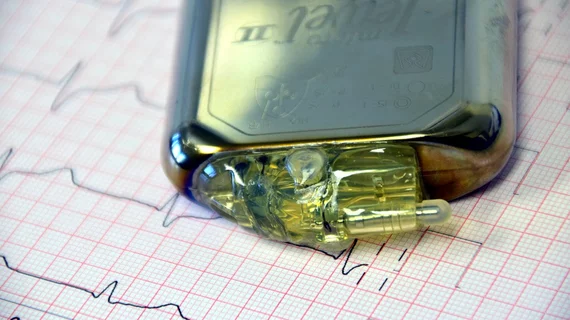Individuals with heart failure with preserved ejection fraction (HFpEF) and atrioventricular block might benefit more from cardiac resynchronization therapy (CRT) than conventional right ventricular (RV) pacing, according to research published in JACC: Heart Failure.
Heart failure patients with reduced ejection fraction (HFrEF) who suffer from dyssynchronous contraction of the left ventricle (LV) have historically seen poor outcomes, first author Li Shen, MBChB, PhD, and colleagues said. Those who show evidence of left bundle branch block in echocardiograms are often referred for CRT or RV pacing, the latter of which used to be the industry standard.
While CRT has a relatively good track record in the cardiac community, conventional RV pacing can cause electrical and mechanical LV dyssynchrony, Shen, of the British Heart Foundation Cardiovascular Research Centre at the University of Glasgow, and co-authors wrote. That can further aggravate a patient’s LV systolic function and HF symptoms, pushing them into dangerous territory.
“Recent guidelines recommended CRT rather than RV pacing for patients with HFrEF who require a pacemaker for atrioventricular block and to consider ‘upgrading’ HFrEF patients to CRT for those who have a conventional pacemaker and a high frequency of RV pacing, either at the time of a scheduled generator change or if the patient has severe or progressive HF symptoms,” the authors said.
They said the potential consequences of RV pacing in patients with HFpEF haven’t been studied.
Shen’s team looked at the impact of conventional RV pacing in a pool of 8,466 HEpEF patients enrolled in the CHARM-Preserved, I-PRESERVE and TOPCAT trials, 8% of whom had a pacemaker at the study’s baseline. Patients with pacemakers were more likely to have lower estimated glomerular filtration rates and blood pressures but higher concentrations of N-terminal pro-B-type natriuretic peptide than their counterparts without an implant.
The researchers examined the link between having a pacemaker and patients’ risk of sudden death, pump failure death, all-cause death, HF hospitalization and CV death. The primary outcome was a composite of CV mortality and HF hospitalization.
Shen et al. reported the primary outcome occurred more often in pacemaker patients, at a rate of 13.6 per 100 patient-years of follow-up (the rate for non-pacemaker patients was 7.6 per 100 patient-years). HF hospitalizations, too, were higher in the pacemaker group—10.8 per 100 patient-years compared to 5.1 in the non-pacemaker cohort—and the risk rate persisted even after adjusting for other prognostic variables.
The authors said the risk of death wasn’t significantly higher in pacemaker patients after adjustment, noting their elevated risk was driven mainly by more HF hospitalizations.
“This finding, along with earlier reports that bundle branch block is also associated with worse outcomes in HFpEF, suggests the possibility that RV pacing-induced LV dyssynchrony may be detrimental in HFpEF patients,” they wrote. “Therefore, it is possible that CRT may be preferable to an RV pacemaker in HFpEF patients requiring pacing for atrioventricular block, although this hypothesis needs to be tested in a prospective randomized clinical trial.”

